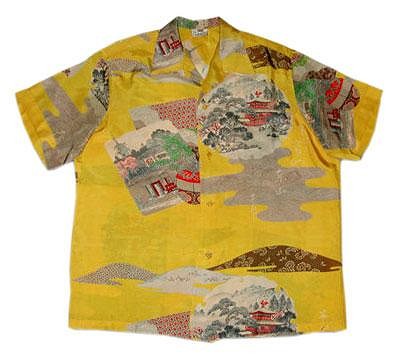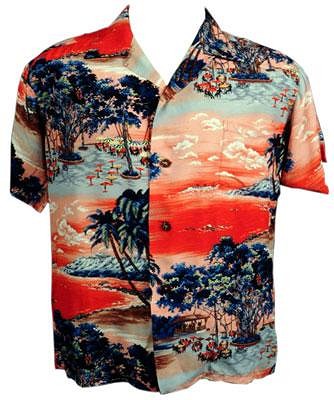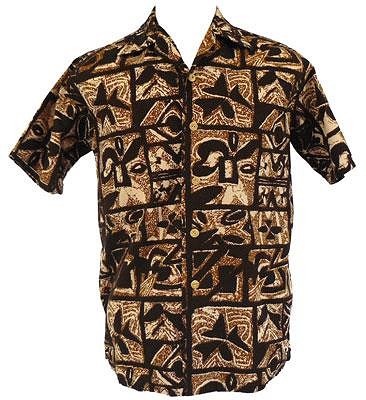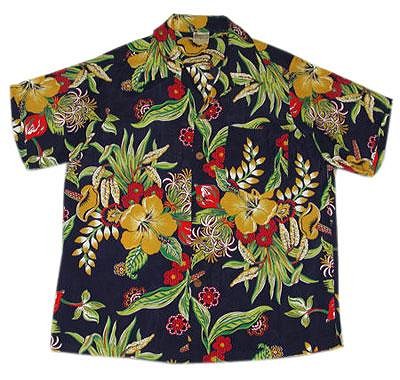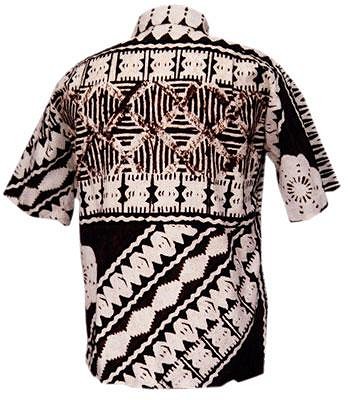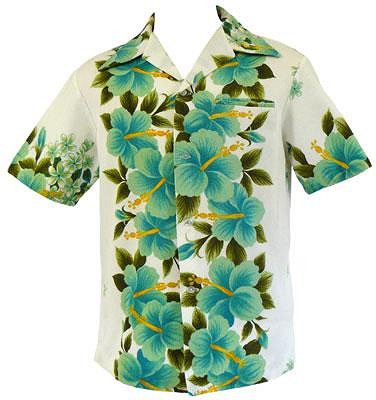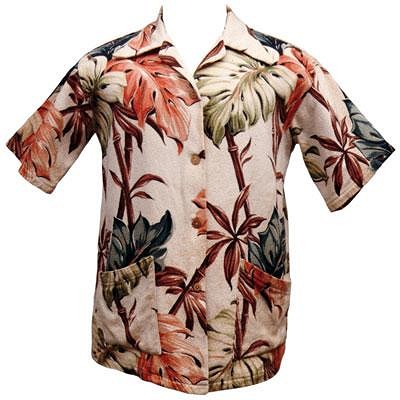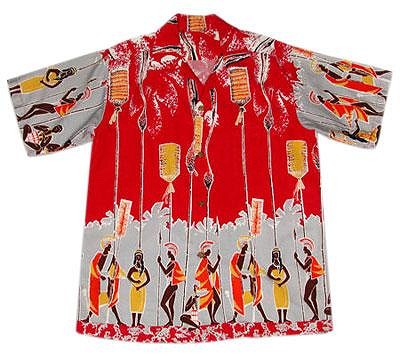Tiki Central / Collecting Tiki / Book on Aloha/Hawaiian Shirts
Post #711098 by MadDogMike on Thu, Mar 13, 2014 10:40 PM
|
M
MadDogMike
Posted
posted
on
Thu, Mar 13, 2014 10:40 PM
TikiLongBeach posted this elsewhere, thought I would share here. Hawaiian Style: The Roots of the Aloha Shirt When I came to Washington State University, I brought my passion for ethnic textiles and clothing with me. Our historic costume collection here at WSU now has increased in size as a result. We now have nearly 100 aloha shirts in our collection here at Washington State University. The University of Hawaii, where I taught from 1991 to 2002, has about 5,000 items of aloha attire, probably half of which are aloha shirts. This collection is in the Apparel Product Design and Merchandising program at the University of Hawaii, and includes 15,000 pieces from around the world going back to the 1700s. It’s a very important collection. Most of the students at the University of Hawaii’s Apparel, Merchandising, and Design program end up in the Hawaiian clothing industry. When the university hired me there really were no accurate books on the history of Hawaiian textiles and clothing. There was one published in the 1980s that was filled with misinformation. I decided to do research and write on the subject so that students and the general public would have comprehensive and accurate information. Hawaiian textiles and clothing are still worn regularly today. It’s a huge industry. Since then I’ve produced six books and countless articles on aloha attire. My first book, “Aloha Attire: Hawaiian Dress in the Twentieth Century,” was published by Schiffer in 1999. It covered the whole history of aloha attire and the goal was to place the aloha shirt in a chronological perspective. It is the only book published to date to cover women’s aloha attire as well as men’s aloha shirts, and to provide dates and values for each garment. Island Heritage Publishers a wonderful publisher of Hawaiian books, brought out “The Art of the Aloha Shirt” in 2002. Later, a Japanese translation of it came out and then last year “Art of the Aloha Shirt” was reissued again, in English, with a new cover. It’s a really thorough book. Desoto Brown, an archivist at the Bishop Museum, co-authored that one with me. He contributed a lot of the book’s wonderful images. In 2000, a sportswear executive named Dale Hope wrote a very good book called “The Aloha Shirt: Spirit of the Islands,” and I have a new history of Hawaiian quilting coming out in the fall of 2010. It’s called “The Hawaiian Quilt: A Unique American Art Form.” So there’s some good work in print now. Collectors Weekly: What did native Hawaiians wear before aloha shirts? Historically, the men wore a loincloth while the women wore a tiny skirt made out of the fabric. When westerners arrived—Captain Cook showed up in 1798—the men in his crew were wearing a loose, square-cut frock shirt with long sleeves and a loose collar. Those were the first shirts on the island. The Hawaiians bartered for the shirts as soon as they could. It was a mark of status to be able to wear new Western-style clothes. By the end of the 19th century, that first shirt had been reduced in size to what most men’s shirts look like today—just the square-cut shirt with buttons down the front. This silk shirt from the 1950s features images you might find on Japanese postcards. Photo: Camille Shaheen Tunberg. This eventually evolved into the aloha shirt. A heavy, blue-and-white plaid cotton fabric arrived from Germany in the 1800s—the material ended up being called palaka in Hawaii and they used it to make long-sleeved shirts. Because the fabric was very heavy, it was useful on the sugarcane and pineapple plantations. Originally the shirts offered some protection for the workers in the fields, but in the early 1900s, they started cutting off the sleeves and using a lighter-weight fabric, which was also called palaka. The shirt went from being a kind of jacket to what we recognize today as an aloha shirt. In 1820, the missionaries arrived, creating permanent settlements of Western residents. They started private schools in Hawaii for their children. One of the first schools was Punahou, which was where President Obama went to school. By the 1920s, a middle class had already developed. There were people who had leisure time, and they wanted something other than work clothes. A group of guys in the private schools decided they wanted to have matching shirts just for fun. So they went to Chinese tailors, who did most of the clothing production on the islands in the ’20s and ’30s, and picked brightly printed Japanese crepe, which had been intended for little-girls’ kimonos—there were a lot of Japanese on the islands, so the tailors kept the fabric in inventory. The shirt was worn outside the pants, not tucked in, which was a radical idea at the time. That tradition came from the Filipinos who were on the islands and wore a traditional men’s garment called the barong tagalog that’s also worn outside the pants. It’s made in a sheer white fabric with embroidery around the placket in the front. These shirts were originally made of pineapple fiber, but now many materials are used. So there were five cultures involved: You had a Western body, a Japanese fabric, Chinese tailors, a Filipino style, and it was made in Hawaii. Throughout the 1930s, the early aloha shirts continued to be made of Japanese fabric, but by the late ’30s, you began to see Hawaiian prints being produced on the islands. The fabric was actually plain white and was stamped with designs that were Hawaiian in character. The term “aloha shirt” was actually trademarked in 1936 by Ellery Chun. He had a dry-goods store and he coined the term, but it was a couple of years later that the actual Hawaiian prints started to be mass-produced. Collectors Weekly: Why are aloha shirts called Hawaiian shirts on the mainland? Collectors Weekly: When did clothing companies come into the picture? Arthur: Kamehameha was one of the first in the late 1930s. There was also Branfleet, which is now Kahala. It’s gone through a number of changes, but Kamehameha was one of the first big ones. Shaheen, however, was the most significant early company; it began in 1948. Alfred Shaheen really made the aloha shirt the icon it is today. He made it into art. The original aloha shirts were called hash prints. Hash is food that is made by throwing whatever is left over into the pot. So they called these early aloha shirts “hash prints” because they literally slapped a hodgepodge of images onto a shirt using linoleum stamps of varied motifs. While it was certainly design, whether it was art is open to debate. Shaheen hired artists and put them on salary, which was unheard of at that time. He took the designers to various locations throughout Asia and the Pacific to inspire their textile designs. For example, Shaheen chartered a plane to Tahiti and left the artists there for a week to absorb the design elements. Many of the Shaheen designs clearly show that multi-ethnic influence. Some of the aloha shirts from the classic period—’45 to ’55—were called silkies, even though the fabric was heavy rayon, which really absorbed the dyes. You got really intense colors that way. Even though these shirts were mass-produced, they routinely sell from $10,000 to $15,000 at auction today. The quality of the artwork is stunning. Up until the 1950s, people on the islands depended on imported fabric. One of the problems with being on the islands is that they are 6,000 miles away from everything, including textile mills. Back then it would take nine months to get fabric. In the meantime, their money was tied up in it. So what if something went wrong? When the Korean situation impacted textile trade, Shaheen realized he had to make his own textiles or go out of business. So he started his own textile printing plant in Honolulu. He used pieces and parts left over from the war to make a textile plant. He developed new processes for making textile dyes, especially metallic dyes, which he often used around the edges of flowers and other motifs to really make them stand out. One of his most famous early designs was created for the shirt Elvis Presley wore on the record cover of “Blue Hawaii.” That’s a very famous print. Collectors Weekly: When did tourists start coming to Hawaii? Arthur: Tourism started at the end of the nineteenth century, but got big after World War II. Tourists were the ones to adopt the aloha shirt because it was too wild for the locals. They wouldn’t wear those crazy prints; they liked subtle things, and that’s still true today. The locals’ style of aloha shirt is still very different from the collectible stuff. The really wild, boldly patterned shirts began after the war. Servicemen during the war were buying aloha shirts as quickly as they could get them, and they brought the fad of aloha shirts back to the mainland U.S. By the ’60s, surfers had brought aloha shirts back to Southern California and developed a craze for them. Those same surfers who brought surfboards and aloha shirts to Southern California in the ’60s are also the people who helped found the casual Friday tradition that was said to have begun in the Silicon Valley. It actually began in Hawaii in 1965 as Aloha Friday. The surfers brought that concept with them to the Silicon Valley. Collectors Weekly: How did Aloha Fridays come about? In Hawaii in the 1960s, people wanted to dress more comfortably. Eventually the legislature came up with a resolution so that people could wear simple aloha shirts on Fridays. And they were required to be really simple—plain fabrics with the only design being on the pocket. Within a few years designs went wild. Collectors Weekly: Did Hawaiian shirt makers have distributors for their aloha shirts on the U.S. mainland? Collectors Weekly: Are Kamehameha’s shirts also collectible? Collectors Weekly: Who wore aloha shirts on the mainland when they first got popular? A lot of celebrities wear them now because the shirts are artistic, valuable, and interesting. It’s a walking art form, and they can afford it. For some of them, the shirt is part of their persona. Collectors Weekly: What are the common motifs and patterns found on aloha shirts? Arthur: It’s changed over time. Today it’s primarily Hawaiian motifs—islands, fish, flowers—but historically there’s been a lot of ethnic imagery as well because Hawaii is multi-ethnic. There is no ethnic majority in Hawaii. So you see a lot of Asian motifs in addition to Hawaiian and Polynesian ones, plus a lot of traditional tapa designs. Every kind of material known to man has been used, but the most valuable shirts are the rayon shirts from ’45 to ’55, and then the fine cottons from the ’50s on. There were some silk shirts, but they’re not as collectible. It’s the quality of the art in the textile that makes them collectible. Shaheen had the best artists. He was in business from ’48 to ’88. He had the market pretty well cornered. Right now, I’d say the best aloha shirts come from Tori Richard, which is not a person but a Honolulu-based company that’s been around for more than 50 years. They’re like Shaheen in that they market to the whole country, not just Hawaii. They target the resort market. Another company, Reyn’s, wasn’t so innovative, but they’re known for the reverse print, which is what a lot of the locals wear. You take a piece of fabric and turn it over to the back, which is a lot subtler than the front of the shirt. They basically use the fabric backwards. That started in the ’60s as well. The designs were often named. Shaheen, for example, would print the name of the fabric along the selvage, or the woven edge. Shaheen documented the names of the prints, which has made it a lot easier for those of us in the curatorial business to identify types. He had thousands of prints. One of his most famous was the Tiare Tapa, which was used for Elvis’ shirt. Then there was the Hukilau [shown at top], a shirt named for the Hawaiian celebration of fishing. Collectors Weekly: Who else did innovative work besides Shaheen? Arthur: There were hundreds of small producers out there. Everybody was trying to make a buck off the aloha-shirt business in the ’50s, ’60s, and ’70s. Kahala produced some really good stuff, and so did Kamehameha in the early days. There was an artist in the ’50s who produced under the Keoni brand. His real name was John Meigs. His shirts are very collectible. The patterns were really abstract and off the wall. There are also some really fine artists of Hawaiian ancestry doing Hawaiian prints. One is Sig Zane on the Big Island. They’re all in Honolulu, except for Sig Zane. Another wonderful designer, Alan James, produces really fine designs based on Hawaiian cultural imagery. One of the best places on Hawaii to buy good Hawaiian designs is Native Books & Beautiful Things. Everything in there comes from ethnic Hawaiians, so you know you’re getting real Hawaiian designs. One of the big problems in Hawaii is you’ve got a lot of tapa prints and designs that come from other Polynesian cultures. People don’t understand that there’s a big difference between Tongan, Samoan, and Hawaiian design. Most of what you see called tapa design is really Samoan, which isn’t Hawaiian. Hawaiian kapa art is more refined than Polynesian tapa. Collectors Weekly: What are the differences between a tapa shirt and a Hawaiian shirt? When looking at historic tapas and kapas, there are differences in the designs and the fineness of the fabric. Especially in the early 19th century, Hawaiian kapas are very soft, a lot like cotton fabrics, and their designs show a great deal of rigidity, control, and precision, much more than we see in the historic Polynesian tapas. While tapa designs are popular in aloha shirts, these designs come and go in terms of popularity. They were hot in the 1930s and again in the ’70s through the early ’90s, but the more typical aloha shirt could not be more different. They are usually covered with a bold floral print. The size of the motifs is also important to collectability. The bigger, bolder, and more obnoxious it is, the more value it has, currently anyway. The trend for the big, in-your-face stuff has been going on for probably 25 years. Collectors Weekly: Why is that? Collectors Weekly: What are some of the other traits collectors look for? Buttons were originally made from pieces of coconut, bamboo, then later of metal, jade, or plastic—any kind of material you can imagine. Metal ones are sometimes made to look like the Hawaiian crest. Shaheen, in particular, produced buttons to go with different outfits. He had ivory ones made in the shape of a Buddha. There were basically three different types of aloha shirts. Most of them buttoned up the front, but some were pullovers. And then there were the reverse prints, which is a type of shirt Shaheen didn’t make. Collectors Weekly: What makes an aloha shirt rare? A hibiscus border print shirt from the 1970s. From the collection of Malcolm Montgomery, Pullman WA. Petroglyphs (rock carvings) were done in Hawaii and these motifs are popular designs commonly found with tapa prints. Fish swimming in the sea is a common design you might see in petroglyphs. Currently, people aren’t as excited about the bark cloth patterns. They like the splashy stuff. In the late ’90s, a lot of bark cloth prints came out in jackets, shorts, and all kinds of things. Kabe crepe shirts are valuable to people who really understand the history. Those are the earliest aloha shirts but that’s not what the collectors are after. More sought after are the Shaheen shirts that focused on Hawaiian pageants. There’s one called the Hukilau, which is the bringing in of the fish. Another focuses on a royal procession. It’s a very important Shaheen design. The quality of the graphics, the color, the condition, and the size make it a good design. Hawaiian people were small for the most part, and the shirts that were produced were small, but the people who are collecting them now are big. So if you can get a large or an extra-large shirt, it’s worth more because you can wear it. Also long sleeved shirts were only produced for a short time and are rare; they are among the most valuable shirts. One sold at Sothebys for over $10,000. Mamo Howell is a designer who always did work that was related to Hawaiian quilts. Like Shaheen, Mamo and some current artists sign their textile designs. On some of her shirts you can see how the pocket matches the print. The buttons don’t interrupt the design. It’s an engineered textile. To do this, the designers need to figure out in advance how much fabric would have to wrap around under the buttons and buttonholes. They’ve printed it out so that they can lap that over, and when the buttons are buttoned, it doesn’t interrupt the design. It wastes a lot of fabric to do that, but you get better design. Tiki designs are also highly collectible, and there’s a fad now concerning tiki designs in fabric for interior decorating. That’s been a real collecting fad in the past five to 10 years. Collectors Weekly: Is it still possible to collect the very early shirts? Wong's Drapery of Hawaii used remnants of heavy cotton barkcloth fabric to make aloha shirts such as this one from 1948. From the CTAHR Historic Costume Collection, University of Hawaii. Drapery shirts are collectible since they’re rare. In the ’30s, ’40s, and ’50s, big floral prints were a very popular design for interior textiles like drapes and slipcovers. They were printed on heavy cottons that were popular for drapes. In the ’40s, Wong’s Drapery in Hawaii made shirts out of their scrap fabric. The shirts probably weighed a pound, whereas nowadays a shirt might weigh two ounces. These were all the rage, especially for kids from Hawaii who were sent to mainland colleges. They’d take these shirts with them because they could wear them to football games and stuff and stay warm. Tourists never adopted them because they were too splashy. But people loved the prints, so the textile designers scaled down these motifs and put them on lighter fabric. That’s another part of the story of the Hawaiian shirt. We started with the palaka, and then went to the Kabe crepe. From there we went to the red print on white with Hawaiian designs, then to the drapery shirts and the florals. Once the shirt was brought down in size, scale, and weight, you end up with the Hawaiian shirt you know today. Collectors Weekly: How do people who wear their collectible shirts take care of them? Turned out that she’d just been putting them in the washer and dryer. I told her to stop it right away because they were worth some serious money. Anyway, she ended up selling the shirts and putting her and her brother through college with the proceeds. Because they were so old—’30s, ’40s—they were quite valuable. The colors were in great shape. But you shouldn’t be washing and drying them all the time, because they shrink, for one thing. And you shouldn’t be wearing them because textiles only last so long. There weren’t very good antiperspirants in the ’30s and ’40s, so the acids in our skin ate up the armpits in old textiles. Collectors Weekly: So what are some good preservation methods? Collectors Weekly: When all is said and done, who is your favorite aloha-shirt designer? Arthur: Shaheen. He focused on making sure that the designs represented Hawaiian culture. It wasn’t just a matter of making a buck; it was spreading the word about the unique American experiment of cultural harmony in Hawaii, of people coming from all these different cultures to a place where there’s no ethnic majority and no one group dominating another. That blending of cultures became very obvious in the textiles that came out of Hawaii. It’s a fascinating story. Shaheen was Lebanese, and his passion for his own culture also blended into the designs. Even though aloha shirts get all the press, women’s Hawaiian apparel really needs to be studied in much greater detail. Women’s aloha shirts are kind of rare, but the master of women’s wear in Hawaii was Shaheen—he could make a woman’s ordinary body look unbelievable with his dresses and sarongs. He put a lot of structure into the garment that shaped and molded the body to look very sexy. Remember Dorothy Lamour and the sarongs? That was a Shaheen design. Those sarongs could make an ordinary body just look like the most incredible sex symbol. One of my students in Hawaii put on one of the sarongs we had in the collection, and I nearly couldn’t get her to take it off. She said: “I have never had a body like this. I don’t know what magic is happening here, but I’m not going to take it off.” Shaheen made built-in bustiers that would move all of a woman’s fat up into her breasts. Women in Hawaii would save an entire month’s salary to buy a Shaheen dress because of what it did for their bodies. (Images by Linda Arthur, Washington State University, unless otherwise indicated. Top image from the CTAHR Historic Costume Collection, University of Hawaii.) |

